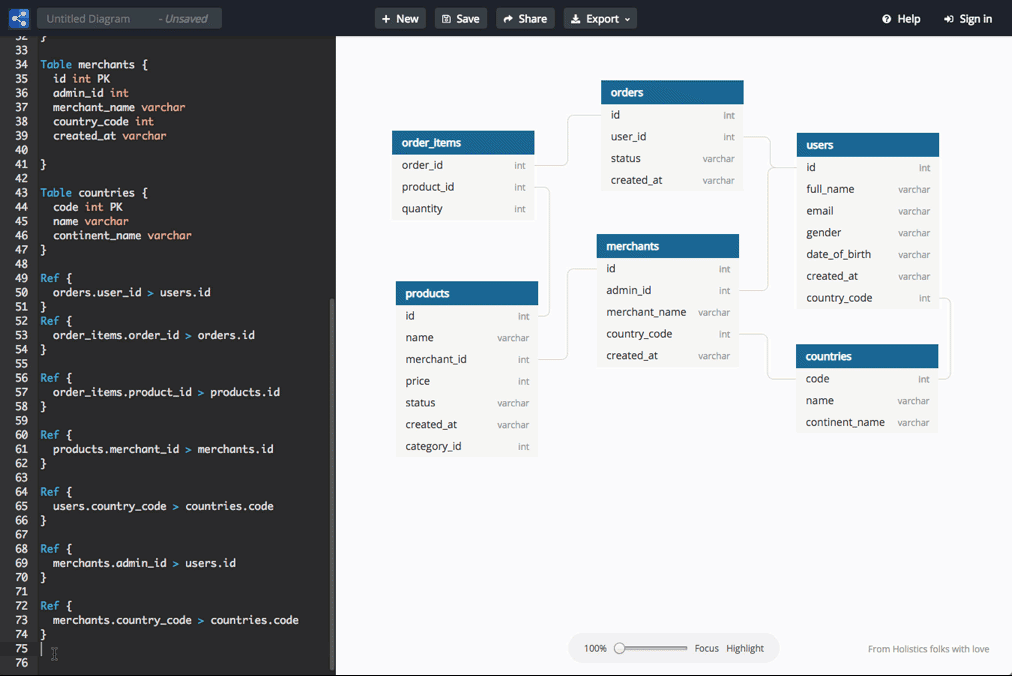Unlocking the Power of Database Design with dbdiagram.io: A Tool for Every System Architect

In today's fast-paced development landscape, visual tools that simplify complex processes are invaluable. One such tool that has gained a solid reputation among system architects, database designers, and developers is dbdiagram.io. This platform allows users to create and visualize database relationships effortlessly, transforming what could be a tedious task into a more intuitive and efficient process.

dbdiagram.io enables users to visually design database schemas and relationships, making it easier to grasp the structure of even the most complex databases. Whether you're working on a small-scale project or a large enterprise system, this tool proves indispensable in understanding how tables interconnect, how data flows, and what relationships need attention. The platform offers support for popular database systems like MySQL, PostgreSQL, and SQL Server, allowing you to design for your specific stack.
One of the biggest advantages of dbdiagram.io is that it is free and easy to use. There's no need to install complex software; everything is accessible from the browser, making it perfect for quick mockups or detailed blueprints. With a simple and readable syntax, you can define tables, fields, and relationships, and dbdiagram.io automatically renders a clean and organized diagram. For those who might not be familiar with the technicalities of SQL or database schemas, this visual approach makes it easier to understand and communicate designs with team members.
Beyond being just a diagramming tool, dbdiagram.io fosters collaboration. As your design evolves, you can easily share it with other stakeholders—whether they are developers, data analysts, or clients—by generating shareable links. This feature is critical when working in teams or presenting your architecture to non-technical stakeholders who need to see the big picture without diving into the code.
Another often-overlooked feature is its export capability. With dbdiagram.io, you can export your designs into SQL scripts, meaning once you’re satisfied with your schema, you can generate the SQL statements needed to bring it to life in your database system. This eliminates the need to manually write migration scripts, significantly speeding up the development process.
In addition to database architects, system designers can also benefit from the tool's simplicity. Visualizing entities and their relationships is key in crafting the foundation of any system, and dbdiagram.io provides an elegant and accessible solution. By using diagrams to communicate the design, you can ensure that everyone on the team—from project managers to engineers—understands how various components are linked.
What makes dbdiagram.io stand out from other tools is its focus on the user experience. The platform’s design is minimalistic, yet powerful, keeping distractions to a minimum and ensuring that your focus remains on the architecture you're building. This simplicity doesn’t come at the expense of functionality—dbdiagram.io is robust enough to handle large, complex schemas without feeling cumbersome.
Moreover, for developers who work in agile environments, where frequent changes to the schema are inevitable, dbdiagram.io makes it easy to iterate. You can modify and update diagrams in real-time, ensuring that your design evolves along with the system. This real-time updating also helps when working in CI/CD pipelines, where database changes must be communicated and documented continuously.

dbdiagram.io integrates seamlessly with other tools you may already be using. For example, you can export diagrams into formats like PNG or PDF for presentations, or into SQL scripts for immediate deployment. This flexibility ensures that the tool can be adapted to fit the workflow of any project, whether it's still in the planning phase or already in production.
Finally, dbdiagram.io is more than just a tool for creating database diagrams—it is a productivity booster for system architects and database designers. By combining simplicity, collaboration, and functionality, it ensures that you can focus on the creative and logical aspects of designing your database, while the tool handles the rest. Whether you're visualizing a new system from scratch or improving an existing one, dbdiagram.io can streamline the process and make your work clearer, more organized, and more efficient.
Try it, and I think you will love it.





Comments ()